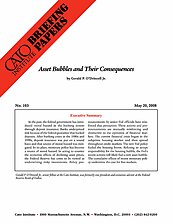In the past, the federal government has introduced moral hazard in the banking system through deposit insurance. Banks underpriced risk because of the federal guarantee that backed deposits. After banking crises in the 1980s and 1990s, deposit insurance was put on a sound basis and that source of moral hazard was mitigated. In its place, monetary policy has become a source of moral hazard. In acting to counter the economic effects of declining asset prices, the Federal Reserve has come to be viewed as underwriting risky investments. Policy pronouncements by senior Fed officials have reinforced that perception. These actions and pronouncements are mutually reinforcing and destructive to the operation of financial markets. The current financial crisis began in the subprime housing market and then spread throughout credit markets. The new Fed policy fueled the housing boom. Refusing to accept responsibility for the housing bubble, the Fed’s recent actions will likely fuel a new asset bubble. The cumulative effects of recent monetary policy undermine the case for free markets.

This work is licensed under a Creative Commons Attribution-NonCommercial-ShareAlike 4.0 International License.

